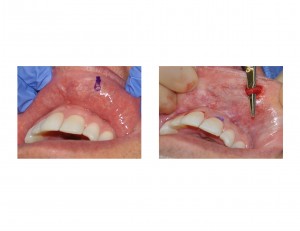Background: Aneurysms of blood vessels can be either true (often caused by atherosclerosis and involving all three components of the arterial wall) or false. (often caused by trauma and involving just a portion of the arterial wall) Most arterial aneurysms are perceived as involving large vessels (e.g., aorta) but they can involve any vessel small or large. Facial vessel aneurysms are very uncommon but involvement of the superior labial artery has been reported in the medical literature numerous times.
In almost every case of a reported superior labial artery aneursym, there has been a history of trauma. In some cases it has been an upper lip laceration, where the injury to the vessels occurs from a partial laceration and the development of the symptomatic aneurysm occurs shortly there after. The other inciting event has been blunt trauma where the lip has been compressed against the teeth. This causes a weakening of the vessel wall and it takes time for the aneurysm to develop which may occur months to years later.
Case Study: A 47 year-old male presented with a chronic and persistent painful pulsing in his left upper lip. It could not only be felt but it could be seen by just looking at the upper lip. It was a discrete pulsating mass that was located on the inner aspect of the upper lip near the midline. He had a history of upper lip bunt trauma about a year before. Its pulsations were a constant nuisance.

Upper lip aneurysms are probably more common than one would think given the exposure of the upper lip to trauma. Lacerations and crushing blunt trauma expose the superior labial artery to potential damage to its wall. Fortunately it is an easy diagnosis to make and to successfully treat.
Case Highlights:
1) Upper lip aneurysms can develop after blunt trauma
2) Often superior labial artery aneursyms are quite discrete and should be suspected with any prior history of significant lip lacerations or blunt trauma.
3) Lip aneurysms can be treated by simple excisions through an intraoral approach.
Dr. Barry Eppley
Indianapolis, Indiana


